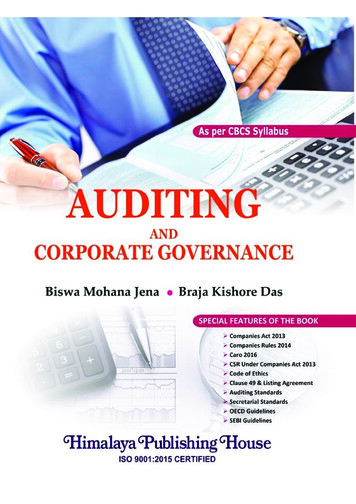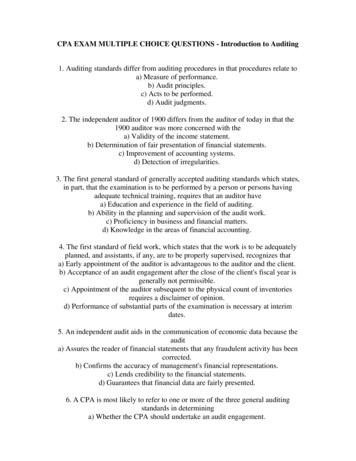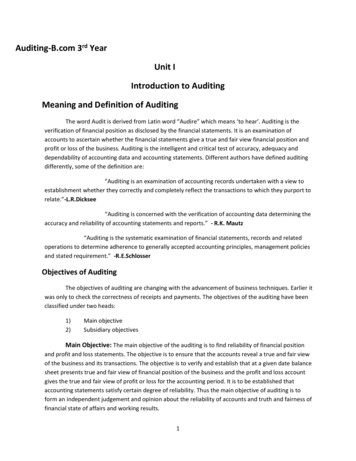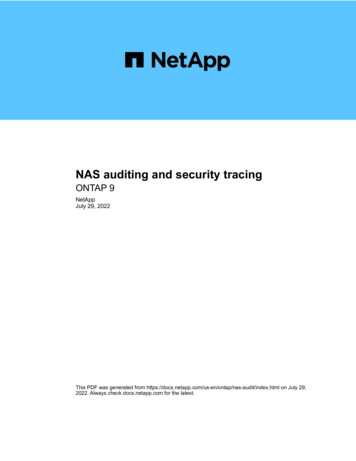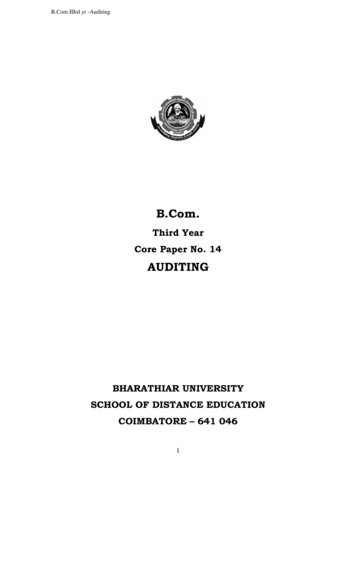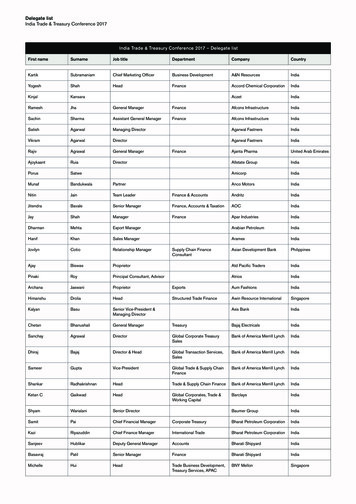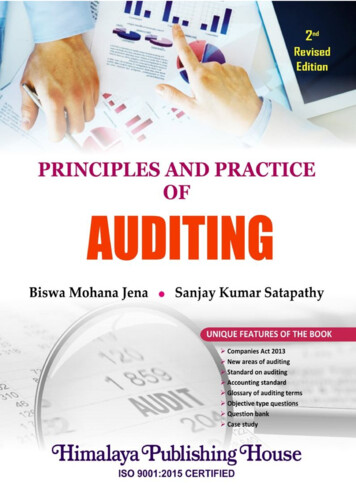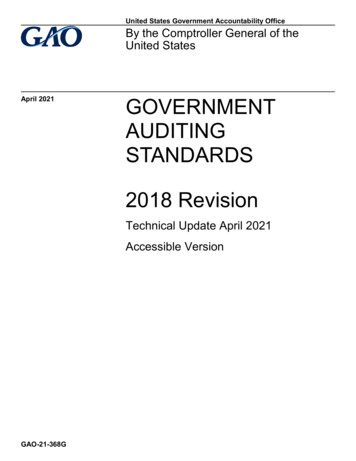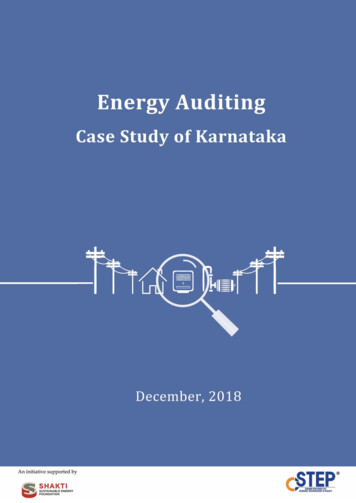
Transcription
Energy Auditing
Energy AuditingCase Study of KarnatakaRishu GargSandhya SundararagavanCenter for Study of Science, Technology and Policy (CSTEP)December, 2018
Center for Study of Science, Technology and Policy (CSTEP) is a private, not-for-profit (Section 25)Research Corporation registered in 2005.Shakti Sustainable Energy Foundation works to strengthen the energy security of India by aiding thedesign and implementation of policies that support renewable energy, energy efficiency and sustainabletransport solutions.Designing and Editing by CSTEPDisclaimerWhile every effort has been made for the correctness of data/information used in this report, neither theauthors nor CSTEP accepts any legal liability for the accuracy or inferences for the material contained inthis report and for any consequences arising from the use of this material. 2018 Center for Study of Science, Technology and Policy (CSTEP)No part of this report may be disseminated or reproduced in any form (electronic or mechanical)without permission from CSTEP.The views and analysis expressed in this document do not necessarily reflect those of ShaktiSustainable Energy Foundation. The Foundation also does not guarantee the accuracy of any dataincluded in this publication nor does it accept any responsibility for the consequences of its use.For private circulation onlyContributors: Rishu Garg, Sandhya SundararagavanThis report should be cited as: CSTEP. (2018). Energy auditing: Case study of Karnataka. (CSTEP-WH-201801).December, 2018Center for Study of Science, Technology and Policy#18, 10th Cross, Mayura Street,Papanna Layout, Nagashettyhalli, RMV II Stage,Bangalore-560094 Karnataka, INDIATel.: 91 (80) 6690-2500Fax: 91 (80) 2351-4269Email: cpe@cstep.inWebsite: www.cstep.in
AcknowledgementsCSTEP is grateful for the support provided by Shakti Sustainable Energy Foundation forconducting this study.We deeply appreciate the valuable feedback provided by Mr Sumanth Shankar Rao (FormerManaging Director, Mangalore Electricity Supply Company Limited) during the course of thestudy. We are thankful to Dr Jai Asundi (Research Coordinator, CSTEP) for his support andencouragement. The authors also acknowledge the editorial team for their support.
Energy Auditing: Case Study of Karnataka1. BackgroundA healthy distribution sector isconsidered as the key to a financiallyviable power sector. One of the majorchallenges affecting the health of Indiandistribution sector is the high aggregatetechnical and commercial (AT&C) loss.AT&C loss is the sum of technical loss andcommercial loss. The technical lossoccurs due to flow of energy intotransmission and distribution network.Technological advancements could helpin reduction of technical loss to anoptimum level. As per internationalnorms, the technical loss in a distributionsystem should be in the range of 4-5%.On the other hand, the commercial loss ismostly man-made and occurs due toinefficient billing and collection of theenergy supplied, illegal connections,theft, meter tampering, and pilferage, etc.The commercial loss is occurring mostlydue to managerial issues and could bebrought down to zero with efficientadministrative practices.HighlightsCurrently, high AT&C loss is considered to be thebiggest challenge of Indian distribution sector.While DISCOMs are working towards bringingdown the AT&C loss through several initiatives,streamlining the current energy audit process inDISCOMs could be a game changer. Some of therecommendations that could be useful, areprovided below: A tagging drive of feeder-DT-Consumershould be considered as an essential first steptowards streamlining the energy auditprocess, as inaccurate tagging leads toerroneous calculation of billing and collectionefficiency.Installation of boundary meters to account forfeeder energy input should be mandated aslack of boundary meters leads to doubleaccounting and inaccurate apportionment ofthe energy input to feeder, (for feedersspanning across multiple O&M divisions).A monitoring group to verify and validate thedata before uploading onto the portal couldhelp in avoiding data entry errors, as sucherrors results in inaccurate calculation ofAT&C loss.Regular maintenance and accuracy checks offeeder, DT and consumer meters should bemandated along with 100% metering. This isbecause while metering is carried out, only 50% of the meters are in good workingcondition.Over the years, the central as well asvarious state governments have initiatedseveral programmes targeted at reducing AT&C loss and enhancing operationalperformance of distribution companies(DISCOMs). In 2001, Accelerated PowerDevelopment and Reform Programme(APDRP) was launched to reduce theAT&C loss to 15%. The scheme could not achieve the desired objective due to limitations inexecution of the programme such as incorrect reporting of AT&C loss by DISCOMs, andinadequate utilisation of funds for network improvement. The scheme was reintroduced in 2008as Restructured Accelerated Power Development and Reform Programme (RAPDRP) with thesame objective of reducing AT&C loss to 15%. The RAPDRP scheme is now subsumed in to theIntegrated Power Development Scheme (IPDS), introduced in 2013. The most recent programmelaunched in this regard is the Ujwal DISCOM Assurance Yojana (UDAY), aimed at improving theoperational and financial health of DISCOMs. One of the main objectives of UDAY is to bring downthe AT&C loss in India to 15% by FY2019.Reduction in AT&C loss is considered to bring both operational and financial efficiency in thedistribution sector as a direct correlation exists between the AT&C loss and financial distress of CSTEPwww.cstep.in1
Energy Auditing: Case Study of Karnatakathe DISCOMs. Therefore, it is important for all the DISCOMs to contain their AT&C loss atnormative levels of 5-10%. Currently, AT&C loss in India is in the range of 6-10% for states suchas Andhra Pradesh, Telangana and in states like Bihar, Jharkhand and Uttar Pradesh, it rangesbetween 30 to 45%.2. Energy Audit for a DISCOMEnergy Conservation Act, 2001, defines energy auditing as the “verification, monitoring, andanalysis of use of energy including submission of technical report containing recommendationsfor improving energy efficiency with cost benefit analysis and an action plan to reduce energyconsumption” (Ministry of Law, Justice and Company Affairs, 2001). Energy audit is used toidentify the AT&C loss by measuring energy input and energy output in the distribution network.It helps to highlight the areas where losses are occurring, and thus, helps to introduce suitablechecks and balances to curb those losses.As per a Ministry of Power (MoP) report, around INR 4,000 crores of revenue is lost due to 1%AT&C loss (MoP, 2015). This amounts to a revenue loss of around INR 1 lakh crore with AT&Closs (at all India level) in the range of 25-26% (MoP, 2018). As long as AT&C loss continues to bein such a high range, it is difficult for the DISCOMs to be commercially viable. Hence, there is anurgent need to identify the areas of waste and leaks, and focus efforts to take corrective action.This could be achieved by conducting energy audits, and highlighting issues such as inaccuratetagging, theft and errors in metering and billing. Energy audit would help in identifying andmeasuring the AT&C loss accurately, thereby aiding DISCOMs to take measures for reducing it.This should result in substantial savings for DISCOMs along with higher revenue earning.Typically, in a DISCOM, energy audit is carried out by consolidating the data in their jurisdictionand conducting analysis so as to measure the quantum of energy loss in the system. The energyreceived from each 11 kV substation is measured for all the outgoing feeders through installationof appropriate energy meters. This provides the DISCOMs with the actual quantity of energy inputto each feeder, every month. The energy input is then compared with the corresponding figuresof monthly energy sales to the consumers, connected to the particular feeder. Difference of theenergy input and monthly sales indicates the loss in each feeder. While quantum of energy lost isobtained through this procedure, it does not aid in segregating the loss into technical andcommercial loss. The MoP report (MoP, 2015) also states that there is no methodology developedso far by any state government or DISCOM to compute technical and commercial loss separately.3. Energy Audit for a DISCOM- Case of KarnatakaKarnataka signed up for UDAY Scheme in June 2016 with an objective of improving operationalefficiency of its DISCOMs. As per the scheme, Karnataka has a target of reducing its AT&C loss to14.2% by FY19. The Karnataka DISCOMs seem to have brought down their AT&C loss over thelast five years. The AT&C loss has reduced from 21% in FY13 to 15% in FY18 (Figure 1). CSTEPwww.cstep.in2
Energy Auditing: Case Study of 5FY16Figure 1: Karnataka AT&C Loss (%) from FY13 to FY18Source: PFC report on performance of state power utilities, UDAY portalKarnataka adopted energy auditing as a major reform initiative in 2001 to calculate energy loss.Karnataka Electricity Regulatory Commission (KERC) developed an energy audit format in2003, to determine technical and non-technical loss separately (Figure 2). Karnataka DISCOMsinitiated the energy audit for 11 kV substations in June 2003 although KERC mandated it inSeptember 2001(CAG, 2011).The most important step in bringing down the AT&C loss is to measure it accurately. While thetechnical loss could be measured based on the specifications of the electrical equipment in thenetwork, commercial loss is mostly unaccounted for. In such cases, energy audit can play acrucial role in accurate assessment of the shares of both technical and commercial loss inoverall AT&C loss figures.The KERC format provides a detailed description on calculation of technical and commercialloss separately.Figure 2: KERC format for energy audit at 11 kV feeder level CSTEPwww.cstep.in3
Energy Auditing: Case Study of KarnatakaEnergy Input, Energy Consumed and Energy LossThe energy fed to the feeders at the entry point is measured at the Karnataka Power TransmissionCorporation Limited (KPTCL) substations using electronic meters. The Assistant Engineer (AE)or Junior Engineer (JE) records the hourly readings from the energy meters of the feeders. Forthe purpose of energy auditing, the energy input (X) to feeder is calculated based on the initialand final reading recorded in the meter connected to the 11 kV feeder:Energy Input (X) (FR – IR) x MCX Energy input to the feeder from the substationFR Final meter reading of current monthIR Initial meter reading of current monthMC Meter constantIf additional energy is imported to the feeder from other sources, then the imported energy (P)is added into the energy input to calculate the net energy input to the feeder.Final energy Input to the feeder (Y) Energy input (X) Energy imported (P)The energy consumed (Z) is available from the monthly bills of the consumers (both high tension(HT) and low tension (LT) consumers) associated with the feeder. The difference between theenergy input and energy consumed gives the energy loss (R) in the network, if the feeder issupplying to the consumers in the same sub-division {Equation (1)}. In case of energy exportedto other sub-divisions from the feeder, the energy loss is calculated as given in equation (2).Energy Loss (R) Energy Input(X) – Energy Consumed (Z) ---------------------------------- (1)Energy Loss (R) [Energy Input(X) – Energy exported (Q)] – Energy Consumed (Z) -----(2)Segregation of Energy Loss into Technical and Commercial LossThe energy loss is segregated into technical and commercial loss by calculating technical loss (S)in the feeder, and associated distribution transformers (DTs).Technical Loss (S) Technical loss in 11 kV feeder (T) Technical loss (Copper and Ironloss) in DTs (U)Technical Loss in the 11kV Feeder (T)The following parameters are required to calculate technical loss in the 11 kV feeder:Load Factor (LF) Energy input to the feeder/ (Peak load X number of hours during the period)Loss load factor (LLF) k x LF (1-k) x LF2Where,k 0.2 for medium voltage feeders and distribution substationDiversity Factor (DF) Connected load (kVA)/Peak load (kVA)Load Diversification Factor (LDF) Connected capacity of DTs (kVA) x Length of the feeder (km)/(kVA x km)KVA x km sum product of the total load incident on each section of the feeder multiplied by itslength. CSTEPwww.cstep.in4
Energy Auditing: Case Study of KarnatakaThe formula for calculation of technical loss in the 11 kV feeder (T) is(0.105 X D2 X L X R X LLF)/ (LDF X DF2 X 2)Where,D Connected load (in kVA)L Total length of the feeder (in km)R Resistance of the conductor per km (ohm/km)Technical Loss in the DTs (U)A distribution transformer experiences various electrical losses inside its core and windings,known as copper loss and iron loss. Since transformer is a static device, no mechanical lossesexist in the transformer and only electrical losses are observed.Copper loss or I2R loss occurs because of heat dissipation due to current passing through thewindings of the transformer and the internal resistance offered by the windings. The copperloss is variable loss and depend upon the variation in the current due to change in load.Iron loss occurs in the core of the transformer and depends upon the magnetic properties of thecore material. Iron loss is constant as it does not change with the load. The technical loss in DTs(U), both copper and iron loss, is calculated based on the number of hours DTs were in service,peak load, power factor, number, and capacity of DTs.Total iron loss (kWh) I x N x t/1000Total copper loss (kWh) C x N x (DTL) 2 x LLF x t/1000Here,I Rated Iron loss of the transformerC Rated Copper loss of the transformerN Number of transformers connected to the feederDTL Loading on the transformer calculated asPeak load (KVA)/Total connected load (KVA)t Number of hours the transformer was working in the year1LLF Loss load factorKERC provides the standard values for iron and copper loss corresponding to different DTcapacity. The sum of iron and copper loss gives the total technical loss in a DT.Technical loss in DTs (U) Total iron loss (kWh) Total copper loss (kWh)The technical loss in 11 kV feeder and DTs, together gives the total technical loss in the feeder.The commercial loss is then calculated as the difference between total energy loss (R) and thetotal technical loss (S):Commercial loss (V) Energy Loss (R) - Technical Loss (S)1As per our discussions with DISCOM officials, a transformer is working with an average of 20 hours in a day. CSTEPwww.cstep.in5
Energy Auditing: Case Study of KarnatakaFigure 3: Schematic representation of KERC format of energy auditingThe loss identified through this format is then compared with the standard values of technicaland commercial loss provided by KERC. DISCOMs can then undertake suitable measures toreduce these losses through network improvement and effective monitoring mechanisms. Aschematic representation of KERC format is provided in Figure 3.4. Issues in Energy AuditCenter for Study of Science, Technology and Policy (CSTEP) identified issues in energy auditingthrough conducting field surveys for sample feeders in select DISCOMs of Karnataka. CSTEP fieldteam validated the data at the field level, and analysed the energy audit reports of 11 kV feeders.Consequently, discussions were carried out with stakeholders at both corporate and sectionoffice level to understand their perspective on energy auditing. We also analysed the currentprocess being followed by the DISCOMs for energy auditing, which is explained below: Step 1: The Assistant Executive Engineer (AEE) at the sub-division records the initial (firstday of previous month) and final (first day of current month) meter reading at the feeder, tocalculate the total energy input to the feeder.Step 2: The sum of billed consumption of all consumers connected to the feeder is the energyoutput from the feeder. The meter reading at the consumer end is usually done on a monthlycycle between 1st and 15th of every month.Step 3: The consumption data is verified by the Assistant Engineer (Technical). The AEEenters the data into the RAPDRP portal for the sub-divisions covered under RAPDRP scheme.For non-RAPDRP areas, web based total revenue management (TRM) software is used.Step 4: The energy audit reports are generated through the software, providing feeder-wisetransmission and distribution (T&D) loss and AT&C loss.Step 5: The reports are consolidated and reviewed at corporate office for any correctivemeasures to be taken for feeders with loss beyond acceptable levels.Based on CSTEP’s analysis of the energy audit reports and field surveys, following issues wereidentified in energy audit: CSTEPwww.cstep.in6
Energy Auditing: Case Study of Karnatakaa) Lack of segregation of energy loss: It was observed from the energy audit reports thatcurrently, only energy loss is calculated for feeders. The DISCOMs have not implemented theKERC format for calculation of technical and commercial loss separately, for all the feeders.b) Inaccurate data entry: The analysis of DISCOM’s energy audit reports revealed that in fewcases, the billed consumption data for the consumers was inaccurate which led to incorrectcalculation of AT&C loss. DISCOMs generally outsource meter reading to an external agency.There is currently no mechanism to periodically validate the data entered by these thirdparty agencies.c) Incomplete tagging: In some cases, it was found that energy utilised (billed consumption) inthe feeder is more than the energy input to the feeder. This can only occur in case of inaccuratetagging of consumers to feeder and DT. Following are some of the other issues related totagging: Consumption data for a few consumers that are physically connected to one feeder was,however, reflected under another feeder in the database Mismatch in DT-consumer mapping in the database and physical connectivity of DTs andassociated consumers New consumers were not mapped with DTs to update the database on a continuous basisd) DT metering: One of the pre-requisites for an effective energy audit is the accurate meteringof DTs. The field survey analysis of feeders and associated DTs revealed the following issues: Incomplete DT metering: It is found that by March 2018, only 55% of metering iscompleted in CESC (tariff order 2017-18) Defective meters: Around 14% of the surveyed DT meters were not recording data due toissues such as Meters Not Recording (MNR), Meters Burnt out (MBO) or no display(Figure 4). There are no proper checks and balances to identify these defective meters. Unconnected meters: For a few DTs (5% of the surveyed DTs), while the meters wereinstalled, they were not connected and hence it could not record the data (Figure 5). Meters placed high: It was found during survey that around 14,000 DTs were installedwith meters which could be accessed remotely, through a central server located in thecorporate office. Due to this, meters were placed high so as to avoid any tampering ordamage to the meter (Figure 6). However, all the DTs associated with the feeder were notconnected with remote access meters, which means that for few DTs, meter reader needto record readings manually. For instance, out of 40 DTs connected to the feeder, remoteaccess meters are provided for only 30 DTs. Remaining 10 need to be read manually. Thiswould result in mismatch in the time synchronisation for manual and online readings,leading to erroneous calculations. The analysis of the server data also revealed that thedaily readings recorded by these meters were not consistent. The inaccurate tagging wasobserved in the server data as well. Location inaccessible: It was found during the survey that the DT locations were notmaintained properly, leading to frequent DT failures (Figure 7). In some cases, DTs werefully covered with bushes and trees, which made it difficult to record the readings. Poor maintenance of DT meters: It was found that DT meters were not maintainedproperly. Even the newly installed DT meters were found infested with rats and birds’nests (Figure 8).e) Single line diagrams: Our survey revealed that single line diagrams (SLDs) were notavailable for most of the feeders. In case of availability of SLDs, they were not updated due to CSTEPwww.cstep.in7
Energy Auditing: Case Study of Karnatakawhich some of the DTs could not be located. Also, SLDs are not updated to reflect replacementor augmentation of failed or old DTs.Figure 5: Meter not connectedFigure 4: Meter Burnt Out (MBO)Figure 7: DT location inaccessibleFigure 6: Meter placed highFigure 8: Bird's nest inside the newlyinstalled DT meterf) Lack of boundary meters: In some cases, it was found that a feeder is supplying energy tomore than one sub-division. In absence of boundary meters, it is difficult to calculate theamount of energy exported to each sub-division by the same feeder. This leads to double CSTEPwww.cstep.in8
Energy Auditing: Case Study of Karnatakaaccounting of energy exported by the feeder as well as inaccurate apportionment of energybetween sub-divisions having same feeder.5.Recommendations for an Effective Energy AuditIt is observed that most of the issues in the energy audit process occur due to lack of monitoringand verification of the data being recorded and entered into the portal. Thus, streamlining of theenergy audit process is the need of the hour. Following are some of the measures which could beadopted by DISCOMs to carry out effective energy audit at feeder level:a) Compliance of KERC format: Implementation of KERC format at feeder level would helpDISCOMs in assessing whether loss is high due to technical or managerial issues. This wouldhelp DISCOMs to take suitable measures on network strengthening or stringent monitoringmechanisms.b) Data entry validation: A mechanism needs to be put in place for regular validation of thedata collected and entered by third party contracts. The DISCOMs employees need tosupervise the meter reading carried out by outsourced party so as to curb any mismatch inthe initial phase of meter reading itself.c) Tagging drive: It is observed that most of the errors occur due to inaccurate tagging offeeders to DTs and DTs to consumers. Hence, a tagging drive is recommended in which allconsumers and DTs are tagged within a stipulated timeframe. Figure 9 provides amethodology which could be adopted for the tagging drive led by a JE. The best performingdivision could be rewarded which could motivate an effective implementation of theinitiative.Feeder to DTtagging usingGPSValidation oftaggingDT to consumertaggingUpdate GISnetwork withnew connectionConduct weeklyreview meetingValidation oftaggingConductfrequent spotchecksReward bestperformingdivision fortaggingFigure 9: Methodology for tagging drived) 100% DT metering and regular maintenance: KERC has recently mandated DT-wiseenergy audit for all DISCOMs. It is important to meter all the DTs so that issues could beidentified between feeder and DTs itself. In addition to completing the DT metering, it is alsoimportant to proactively maintain the meters so as to avoid any short-circuit.e) Availability of SLDs and continuous network updation: The tagging drive would aid indeveloping SLDs for all the feeders. Also, these SLDs should be updated on a continuous basis CSTEPwww.cstep.in9
Energy Auditing: Case Study of Karnatakawith addition of new DTs, and consumers. This would also help in tracking the expansion ofthe network in any particular area.f) Installation of boundary meters: Installation of boundary meters should be mandated inevery sub-division in order to record energy received from each 11 kV feeder distinctly. Thiswill help in correct estimation of energy input from each feeder in a given area. Also, energyinput and energy utilised needs to be captured on a regular basis in the database for accuratecalculation of feeder-wise loss.g) Streamlining of energy audit process: The energy audit process in a DISCOM needs to bestreamlined through a mechanism of assessor and monitoring group. This process wouldensure purging of the errors occurring due to lack of monitoring and verification of thecollected data. Figure 10 illustrates the proposed energy audit process including bothassessor and monitoring group. The assessor group is the operational group and would beinvolved in data collection, data entry, preparing and consolidating energy audit reports. Themonitoring group would validate and verify the accuracy and authenticity of the datacollected and consolidated by assessor group.The JE at the section office, records the feeder meter reading and calculates the energy inputto the feeder. The meter reader or lineman records the consumer meter readings, the sum ofwhich gives the energy output of the feeder. During the recording of consumer meter readings(the billing cycle), both assessor and monitoring group should make sure that accuratetagging is done from feeders to DTs and DTs to consumers. The JE and Lineman (Assessorgroup) should be responsible for accuracy of tagging, and an AE (Monitoring Group) shouldvalidate and verify the tagging process along with updation of new connections.The AE, at the division office, will consolidate the feeder level energy audit reports, and alsohighlight any discrepancies in the consolidated energy audit report, on bi-weekly basis. Thediscrepancies need to be discussed with the Executive Engineer (EE), who would then suggestany corrective action to be undertaken for resolving discrepancies.The Superintendent Engineer (SE) shall review the energy audit report for high-level taggingissues and feeders with high loss, on monthly basis. The corrective action plan suggested bySE should be adhered to and updated in the next monthly meeting.The proposed process is expected to ensure that Feeder-DT-consumer tagging is updatedevery month with onset of the billing cycle. Furthermore, it would make the field-levelfunctionaries more accountable to ensure the correctness of the energy audit reports. CSTEPwww.cstep.in10
Energy Auditing: Case Study of KarnatakaAssessor GroupSection (O&M)LevelJEFrequencyFeeder meter readingData EntryDT to Feeder taggingLevelHourlyDaily3 itoring GroupConsumer & DT meterreadingsConsumer to DT taggingGenerate energy auditreportsReport discrepanciesstActivitiesMonitor tagging of newconnectionsValidate taggingFrequency3-4 monthsth1 -15 of everymonthMonthlyBi-weeklyEEDiscussion on discrepanciesBi-weeklySECorrective actions fortagging & high loss feedersMonthlyCorrectiveactionEnergyAudit TeamTagging StatusHigh loss feedersMonthlyFeedbackFigure 10: Proposed Energy Audit Process CSTEPwww.cstep.in11
Energy Auditing: Case Study of Karnataka6.ReferencesCAG. (2011). CAG Audit report on performance of government companies in Karnataka(Perfrormance report). Bangalore.MoP. (2015). 12th report of Standing committee on energy (16th Lok Sabha), MoP- Measures tocheck commercial losses; Presented to Lok Sabha on 11.12.2015 Laid in Rajya Sabha on14.12.2015 (Report) (p. 100). New Delhi: Standing Committee on Energy.MoP. (2018, August). UDAY Portal. Retrieved 27 August 2018, fromhttps://www.uday.gov.in/atc india.php CSTEPwww.cstep.in12
analysis of use of energy including submission of technical report containing recommendations for improving energy efficiency with cost benefit analysis and an action plan to reduce energy consumption" (Ministry of Law, Justice and Company Affairs, 2001). Energy audit is used to identify the AT&C loss by measuring energy input and energy .
